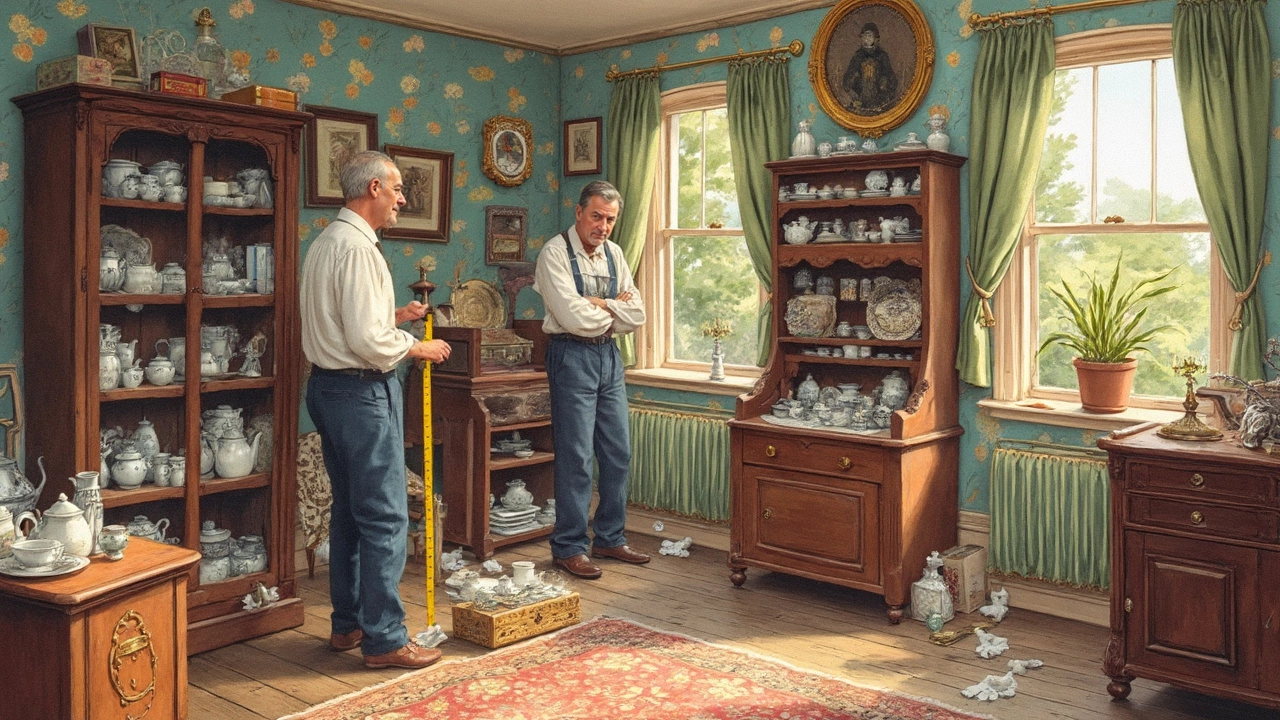It might seem like a good idea to store everything right at home where you can easily access your stuff, right? But, have you ever stopped to think about the downsides of squeezing everything into your own space? From barely having room to move around to dealing with unexpected expenses, there’s a lot more to consider.
Setting aside areas in our homes for storage often means sacrificing living space. Suddenly, your spacious spare room becomes a cluttered storage hub. Who wants to constantly dodge boxes just to find their coat?
And then there are the hidden costs. Ever thought about how much more you need to spend on organizing tools, security measures, or even additional property taxes due to modifications? Keeping everything in-house is not as cheap as it appears at first glance.
- Space Constraints
- Hidden Costs
- Security Concerns
- Climate Control Issues
- Maintenance Hassles
- Tips for Effective In-House Storage
Space Constraints
When it comes to in-house storage, the first hurdle most people face is simply having enough room. This is especially true if you're living in a bustling city like London or Bristol, where every square meter seems to be precious real estate.
Quite often, dedicating a part of your home to storage means compromising on functional living space. Ever notice how your attic or basement piles up, turning into a cluttered mess faster than you'd expect?
“Clutter is nothing more than postponed decisions,” says Barbara Hemphill, a leading organizational expert.
That decision often ends up being 'where can I put one more box?' Eventually, your guest room, which could host friends or family, just becomes a catch-all for those rarely used items.
Finding Space Within Limits
One approach to managing limited space is optimizing what you have. Consider installing smart shelving in awkward spots or using multi-purpose furniture, like a bed with built-in drawers. But, there's only so much you can do before things become cramped.
Room for Comfort
It's important to ask yourself a straightforward question: How much is too much? Piling up belongings might give a sense of preparedness, but at what cost to your comfort and mobility?
Re-Evaluating Needs
- Do regular checks to decide what to keep, sell, or donate. It helps in avoiding sentimental clutter.
- Think about reducing altogether. Do you really need five sets of kitchen appliances?
Being strategic with your in-house storage setup can make a big difference. It's about finding that sweet spot between keeping what you need and maintaining a home that's comfortable to live in.
Hidden Costs
When you decide on in-house storage, it's easy to overlook the costs that sneak up on you. Sure, you might save on monthly fees for a storage unit, but the expenses don't just stop with stacking boxes up to the ceiling. Let's break down some of these hidden costs that often catch people off guard.
Organizational Tools
First off, you'll likely find yourself spending more on organization. Buying storage bins, shelves, and labeling systems can add up quickly. Before you know it, you're investing a significant chunk of change just to keep your stuff somewhat accessible.
Home Modifications
Don't forget about potential home modifications. Maybe you need a new shelving unit or a more robust security system. If you're considering making any structural changes, like adding built-in cabinets, you should be prepared for a hefty bill. Sometimes, these changes even necessitate permits or professional help, pushing costs even higher.
Increased Utilities
Then there's the matter of utilities. Storing items that require specific climate conditions means your heating or cooling bills could skyrocket. Keeping your home at a constant temperature suitable for storage can run up quite a tab each month.
Opportunity Cost of Space
Lastly, consider the opportunity cost of the space you're using for storage. By cramming your spare room with odds and ends, you're losing out on the potential revenue or enjoyment that extra space could bring. Whether it's a new guest room or a home gym, those lost opportunities also count as costs.
| Expense Type | Average Cost |
|---|---|
| Organizational Tools | £200-£500 |
| Home Modifications | £1,000+ |
| Increased Utilities | £100+/year |
| Opportunity Cost of Space | Varies greatly |
While some of these costs might seem small at first, they can quickly add up, taking a bite out of your budget in ways you didn't expect. Being aware of these potential expenses allows you to plan ahead and decide if in-house storage is really the best choice for your wallet.
Security Concerns
When it comes to in-house storage, security might be one of those things you don't think much about—until something goes wrong. Keeping everything at home means you're responsible not just for storing items but also for keeping them safe.
Potential Break-Ins
Let's face it, homes aren't naturally equipped with the same security measures as commercial storage facilities. If a burglar gets in, they have direct access to everything. Unlike a storage unit with various locks and often CCTV, your house might only have a basic lock or alarm system. Consider upgrading your current security features if you're increasing the value of items stored at home.
Internal Risks
Ever thought about who knows what's stored in your space? From guests to household staff, internal threats might not always be on your radar. While accidental exposure isn't planned, being mindful of who has access to your storage areas doesn't hurt.
The Element of Natural Disasters
This might not be the first thing you think about, but what happens if there's a flood, fire, or earthquake? Natural disasters are unpredictable, and while a storage facility may offer some assurances, safeguarding your home for every possible scenario can become overwhelming. That’s why having insurance covers could be a lifesaver.
Practical Steps for Better Security
- Upgrade locks to deadbolts or smart locks for enhanced protection.
- Install security cameras in entryways and storage areas.
- Use a safe for smaller valuable items.
- Consider motion sensor lighting around the perimeter of your home.
By taking some practical steps, you can boost the security of your home storage. A little investment in safety now can save a lot of heartache down the line.

Climate Control Issues
When it comes to storing your stuff at home, one often overlooked factor is the climate control. Think about it: the conditions inside your house can significantly affect the longevity and condition of your stored items.
If your storage areas are too humid or too dry, it might lead to problems like mold growth, warping, or cracking. This is especially true for items made of wood, paper, or fabric. Imagine pulling out your favorite books only to find them with moldy spots all over!
According to John Smith, a storage expert at In-House Storage Solutions, "Proper climate control is crucial. Without it, you're not storing your items; you're slowly ruining them."
Common Climate Control Challenges
Here's what you should watch out for:
- Temperature Fluctuations: Big changes in temperature can cause materials to expand and contract, which is bad news for those family heirlooms or old vinyl records.
- Humidity: Too much moisture is a breeding ground for mold and mildew. Not exactly what you want for grandma's quilt.
- Poor Air Circulation: Stagnant air can contribute to both temperature and humidity issues.
How to Manage Climate Control
So, what can you do? Here are a few practical tips:
- Invest in a dehumidifier to keep moisture levels in check, especially in basements or attic spaces that naturally collect dampness.
- Use fans or air purifiers to ensure good air circulation.
- Consider installing insulation in areas you use primarily for storage. It helps stabilize temperatures and prevent the effects of extreme weather.
Remember, maintaining proper climate conditions not only protects your belongings but also saves you the trouble (and cost) of replacing damage-prone items.
Maintenance Hassles
When it comes to managing in-house storage, maintenance can often become one huge headache. It's not just about tossing your things into a designated space and forgetting about them. You've got to keep everything organized, clean, and in good condition.
Regular Cleaning and Upkeep
First off, let's talk about cleaning. Dust accumulates quickly, especially if your storage area isn't sealed off properly. Cleaning a cluttered, tightly-packed space? That's not fun. Plus, your stored items could attract pests if you're not careful. Nobody wants that kind of surprise, right?
Routine Inspections
Think of your storage spaces as needing check-ups, just like doctor visits. It's essential to regularly inspect the condition of stored items. Are they still intact? Any signs of wear or damage? Keeping an eye out helps avoid nasty surprises.
Spoilage and Deterioration
| Item | Average Lifespan |
|---|---|
| Electronics | 5-7 years |
| Leather Goods | 10-15 years with proper care |
| Paper Documents | Indefinite if stored properly |
Believe it or not, items can start to deteriorate if they're not stored right. Electronics might get fried if the space gets too humid. Leather goods can crack and fade. And those important documents? They might get damaged if you don't store them in a dry, clean spot.
Handling and Reorganizing
Every time you want to find something, it often means rearranging. That's another potential problem — the more you move things around, the more likely you are to accidentally damage them. Not to mention, it eats up time you could spend doing something way more exciting.
Bottom line: handling maintenance for in-house storage is no small feat. Regular upkeep, vigilant inspections, and careful handling can make all the difference, but it all requires a solid commitment.
Tips for Effective In-House Storage
Managing all your stuff at home without turning it into an episode of Hoarders can be quite the balancing act. But don't worry, here are some practical tips to help maximize your in-house storage efficiently without losing your mind (or your floor space).
Go Vertical
One of the handiest tricks is going vertical. Use wall-mounted shelves or tall cabinetry to utilize lesser-used space. Not only does this free up the floor, but it also makes everything easier to see and access.
Invest in Multipurpose Furniture
Think about furniture that doubles as storage solutions. Ottomans and benches with built-in storage hide your clutter in plain sight. Also, consider beds with drawers underneath, which can be a lifesaver in tight spaces.
Declutter Regularly
Here's a hard truth: sometimes the best storage solution is getting rid of stuff you don't need. Set a regular schedule for decluttering. If you haven’t used something in over a year, it might be time to say goodbye. Marie Kondo said it best,
“Keep only those things that speak to your heart.”
Label Everything
This might seem basic, but labeling storage boxes and containers saves a lot of time. There's nothing worse than opening 10 boxes just to find your winter scarf. Clear, concise labels can make your home storage journey much smoother.
Use Clear Containers
See-through containers are a game-changer for finding stuff quickly because you can spot what you need without playing hide and seek with your belongings.
Implement a Rotating System
If you face seasonal storage issues, consider a rotating system. Swap clothes and gear between seasons, keeping only the items you need accessible while storing away the rest. This approach keeps things fresh and prevents clutter.
Remember, the key is to prioritize functionality. By keeping these tips in mind, you'll make the most out of your in-house storage without feeling like it's taking over your life.

